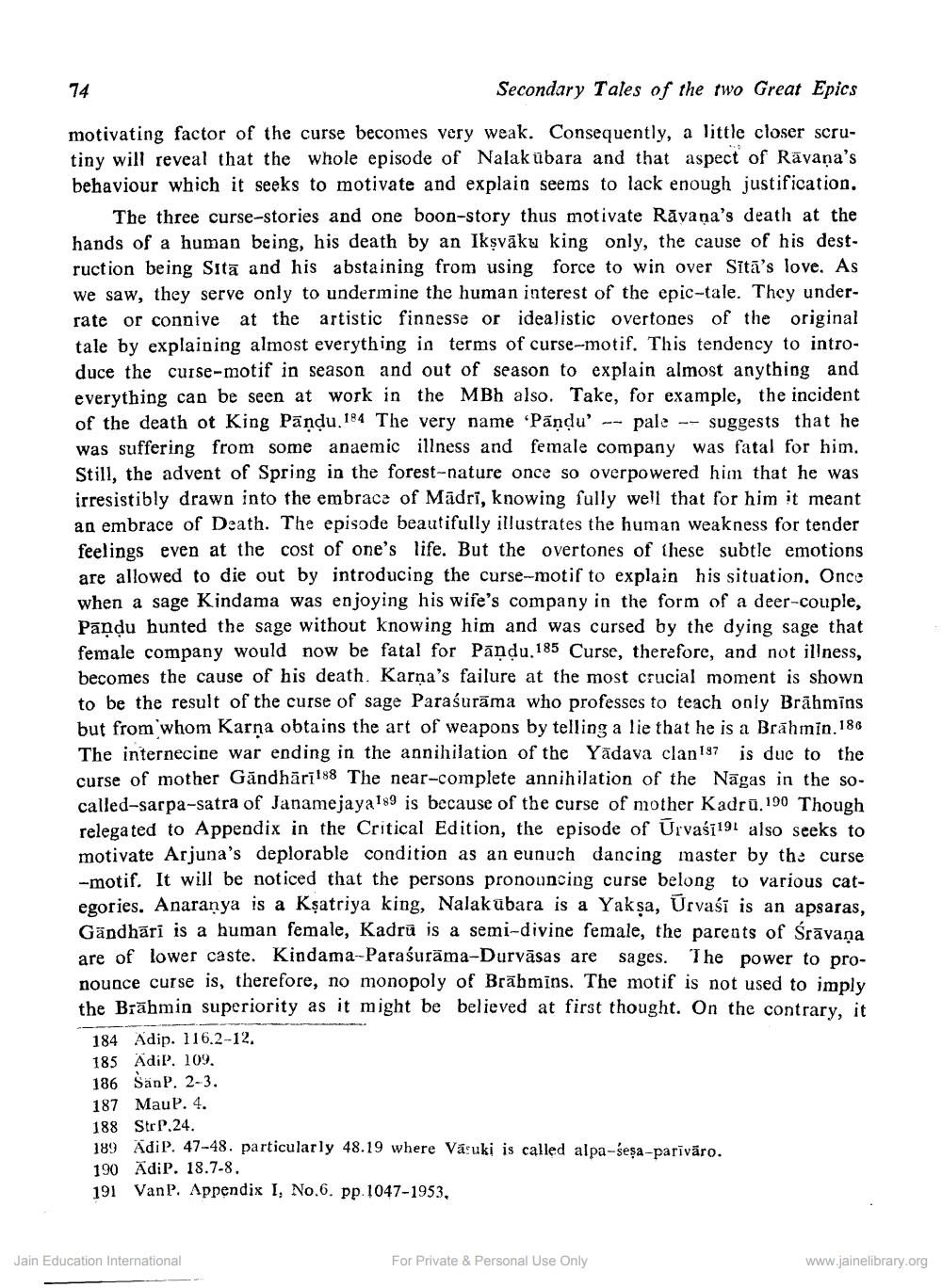________________
74
Secondary Tales of the two Great Epics
motivating factor of the curse becomes very weak. Consequently, a little closer scrutiny will reveal that the whole episode of Nalak übara and that aspect of Rāvana's behaviour which it seeks to motivate and explain seems to lack enough justification.
The three curse-stories and one boon-story thus motivate Rāvana's death at the hands of a human being, his death by an Ikşvāku king only, the cause of his destruction being Sita and his abstaining from using force to win over Sitā's love. As we saw, they serve only to undermine the human interest of the epic-tale. They underrate or connive at the artistic finnesse or idealistic overtones of the original tale by explaining almost everything in terms of curse-motif. This tendency to introduce the curse-motif in season and out of season to explain almost anything and everything can be seen at work in the MBh also. Take, for example, the incident of the death ot King Pāndu. 184 The very name Pandu' -- pale -- suggests that he was suffering from some anaemic illness and female company was fatal for him. Still, the advent of Spring in the forest-nature once so overpowered him that he was irresistibly drawn into the embrace of Mādri, knowing fully well that for him it meant an embrace of Death. The episode beautifully illustrates the human weakness for tender feelings even at the cost of one's life. But the overtones of these subtle emotions are allowed to die out by introducing the curse-motif to explain his situation. Once when a sage Kindama was enjoying his wife's company in the form of a deer-couple, Pandu hunted the sage without knowing him and was cursed by the dying sage that female company would now be fatal for Pandu.185 Curse, therefore, and not illness, becomes the cause of his death. Karna's failure at the most crucial moment is shown to be the result of the curse of sage Paraśurāma who professes to teach only Brāhmins but from whom Karna obtains the art of weapons by telling a lie that he is a Brāhmin. 186 The internecine war ending in the annihilation of the Yādava clan187 is due to the curse of mother Gāndhārī 188 The near-complete annihilation of the Nāgas in the socalled-sarpa-satra of Janamejaya189 is because of the curse of mother Kadrū.190 Though relegated to Appendix in the Critical Edition, the episode of Urvasi191 also seeks to motivate Arjuna's deplorable condition as an eunuch dancing master by the curse -motif. It will be noticed that the persons pronouncing curse belong to various categories. Anaranya is a Kşatriya king, Nalakubara is a Yaksa, Urvasi is an apsaras, Gandhāri is a human female, Kadru is a semi-divine female, the parents of Śrāvana are of lower caste. Kindama-Parasurama-Durvāsas are sages. The power to pronounce curse is, therefore, no monopoly of Brābmīns. The motif is not used to imply the Brāhmin superiority as it might be believed at first thought. On the contrary, it
184 Adip. 116.2-12. 185 AdiP. 109. 186 San P. 2-3. 187 MauP. 4. 188 Str P.24. 189 AdiP. 47-48. particularly 48.19 where Vásuki is called alpa-seșa-parīvāro. 190 AdiP. 18.7-8. 191 VanP. Appendix I, No.6. pp.1047-1953,
Jain Education International
For Private & Personal Use Only
www.jainelibrary.org




